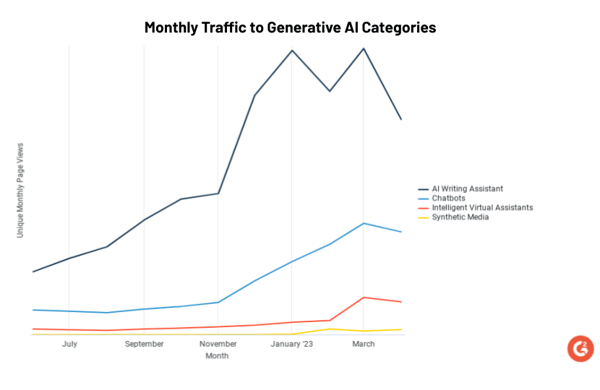I attended Salesforce’s Tableau Conference 2023 (TC23) from May 9 to May 11, which revealed a new direction for machine learning (ML) and data analytics in the SaaS industry. The phrases “generative AI” and “large language models” were said more times than I could count, and most conversations at some point led back to ChatGPT.
This brings us to some critical questions.
Are we all riding a marketing hype train that will eventually come to a halt when people realize the limitations of large language models (LLMs)? Or is the tech industry at a crossroads similar to when search engines like Google came out and inspired skepticism? I posit we are between these extremes, but I lean toward believing that generative AI is a paradigm shift.
Reflecting on the generative AI fervor, I question what this means for the supply chain business, which is perpetually a decade behind in technology adoption.
If spreadsheets without data governance policies are only now losing their predominance, how can supply chain managers reckon with the burgeoning path toward generative AI?
Let’s take a look.

Big tech is placing all bets on generative AI
From Google’s Bard to Meta’s LLaMA, Big tech companies are putting all hands on deck to launch generative AI products. Salesforce and Tableau executives unveiled Tableau GPT and Tableau Pulse at TC23.
Tableau GPT uses Salesforce LLMs, external models from OpenAI, Cohere, and Anthropic, and Tableau analytics to summarize information from data sources, provide natural language insights, and produce compelling visualizations.
One of the greatest strengths of generative AI is the ability to speed up and tighten coding, and Tableau GPT provides this capability as well through amplifying existing functionalities with the data-wrangling tool Tableau Prep. If a developer needs to pull customer emails from complex JSON data structures, Tableau GPT quickly generates regular expressions and Python code. Any programmer will tell you writing regular expressions can be tedious, so Tableau GPT aims to save them time and speed up production.
Tableau GPT then powers Tableau Pulse, which launches in pilot mode in the second half of 2023.
Tableau Pulse suggests questions for users to ask to discover new relationships among the data and aid with data-informed business decisions. Anticipating problems that users may have is one of Pulse’s novel capabilities, and that helps drive insight-backed decisions for people who may lack data literacy or the time to dig further.
In addition, Pulse delivers digests to users in their existing flow of work, with automatically generated natural language summaries and data visualizations of the metrics relevant to them.
Generative AI can potentially increase data-driven decisions
Senior Director of Product Management at Tableau Katie Hughes highlights that only 30% of people in an organization use business intelligence and analytics to inform their daily work. It’s mainly data scientists, analysts, and research professionals working regularly with company data. This parallels my past research that showed significant gaps in data-literate, digitally savvy talent in the supply chain. While many companies rely on recruiting young, external candidates to address this issue, I believe the most significant investment involves upskilling existing employees. Tableau Pulse seeks to do just this.
“It is traditionally people who know and love data who are taking advantage of it. It’s the people in the middle managing teams–a regional sales leader, a call center director–who are also asked to be data-driven. But they are not equipped with the tools to do so.”
Katie Hughes
Senior Director of Product Management, Tableau.
Hughes states that 70% of people not using data in their work is a market Tableau Pulse specifically targets.
In the supply chain, this could be warehouse managers, truck drivers, and the worker bees keeping things moving. A warehouse manager likely does not have the same confidence in interpreting data as a master’s-level data scientist. But with suggested questions and answers powered by the Tableau GPT engine, Pulse aims to help non-technical users find the answers they need. A warehouse manager could, for example, ask how productivity was this month compared to last. They could then drill into the data to discover the source of lags, stagnation, or increases in productivity.
“It’s a combination of natural language and visualization. It will answer what is happening, why, and what I should do about it,” said Hughes.
But what about the downsides of large language models?
Despite the excitement over generative AI, these models have well-documented flaws.
“Hallucinations” happen when LLMs confidently state incorrect information. This mustn't happen with companies' business decisions in an era where misinformation can have devastating impacts. And Tableau ML specialists, such as the head of Generative AI, Dr. Nate Nichols, are aware of this.
Hallucinations occur because LLMs are trained on the internet, which includes large amounts of misinformation or partially true information. To avoid this pitfall, Tableau GPT is separate from the actual process of quantitative analytics. Instead, Tableau’s existing capabilities analyze the data, and Tableau GPT generates the language to summarize the data. In doing this, Tableau seeks to bypass the risk of hallucinations that could lead to misguided business decisions.
What does the generative AI hype mean for the logistics business?
The generative AI fever is real, and G2 monthly traffic data from June 2022 to April 2023, pulled on May 16, 2023, confirms this.

ChatGPT was launched on November 30, 2022, and we have seen significant increases in traffic from December 2022 and forward in specific Generative AI categories, as well as the creation of the Synthetic Media category. While it’s easy to write off the hype as a marketing ploy, LLMs are already demonstrating compelling use cases. But how does this relate to the supply chain, one of the most notoriously laggard industries regarding technology?

Generative AI tools such as Tableau Pulse could aid in increasing data literacy and accessibility in supply chain organizations by expanding to a non-technical user base.
Digitally upskilling existing logistics employees is a wise investment for supply chain leaders, and the data summarization, visualization, and suggestion capabilities of LLMs have the potential to do just that. But the question always remains, will supply chain professionals innovate?
In addition, the emergence of industry-specific analytics tools like Logistics Intelligence Software (G2’s newest supply chain category) makes me question if supply chain managers will invest in industry-agnostic platforms like Tableau that include the latest product innovations, such as generative AI and embedded analytics.
Ultimately, I purport supply chain managers must invest in industry-agnostic and logistics-specific platforms. In doing this, they can build scalable solutions that unite users and provide advanced analytics modules while still accessing tools for specialized logistics problems.
Going back to Trends 2023, I posited that leaders would rise and fall based on their openness to innovation, ML, and analytics. Generative AI, thus, represents another opportunity for leaders to continue widening the chasm between themselves and their competitors.
In essence, the fear of losing one’s place in the market will likely drive the imperative to innovate versus an inherent interest. While LLMs may not have as seismic of an impact on logistics as they will with other industries, they could still accelerate the implementation of a data-informed strategy, which I passionately advocate.
The path forward
While these latest technological developments are promising, I question the ability of industry-agnostic platforms like Tableau with those features to penetrate the supply chain market. Although Tableau has Accelerators that allow vendors to customize their dashboards, this would entail an extra charge and time.
After all, the Logistics Intelligence category offers industry-specific modules, data sets, and third-party research for more targeted predictive analytics. Given supply chain managers’ reluctance to take risks, one would expect them to gravitate toward logistics-specific solutions. However, I don’t think the answer is that simple.
Big Tech platforms such as Tableau also offer embedded analytics, another feature highlighted at TC23. Embedded analytics entails scaling Tableau across multiple systems to act as a unified source of truth and analysis. Doing this allows a single platform to bring together all company data in one place.
Considering the supply chain can involve dozens of stakeholders, databases, and software solutions, the value of embedded analytics cannot be understated. Thus, I believe the path forward is a synergy between Big Tech analytics platforms and industry-tailored solutions.
Stay ahead of the competition
The bottom line is supply chain vendors must invest in B2B software to keep up with the rapidly advancing global economy. Storing and analyzing data in Excel are anachronistic reminders of the way businesses used to run, and supply chain professionals who fail to move beyond this will fall behind their rivals.
Check out G2’s supply chain, analytics, and artificial intelligence categories today to get a leg up on your competition.
Edited by Shanti S Nair


 by Anthony Orso
by Anthony Orso
 by Anthony Orso
by Anthony Orso
 by Anthony Orso
by Anthony Orso